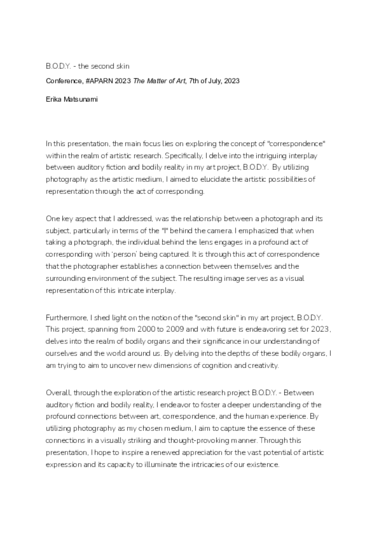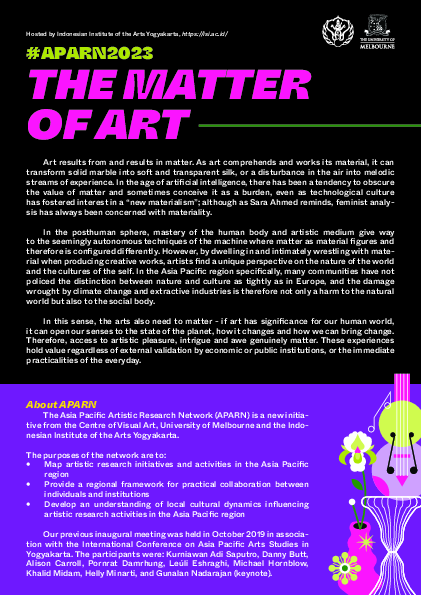Year by year, the quality of artistic research is getting deeper and is explored profoundly. And artistic research is definitely permeating society.
After the end of art (the end of the Western classic art world), these two book reviews has a new (unconventional) perspective of art in art criticism.
The goal of my artistic research is to explore the knowledge that differs from Western classical knowledge, i.e. not Western ontological knowledge, which is imitated as if a Western knowledge.
My research is for methodology, so my proposal is meta-epistemological.
For that the natural science is important.
For roughly two centuries, there has been an ongoing rivalry between two views of art. On the one hand, there is the claim—sometimes heralded by the slogan ‘art for art’s sake’—that art is a realm unto itself. Call this autonomism. Art is autonomous or separate in virtue of its singular essence from the rest of society, its concerns, and its practices. On the other hand, there is the older view—found in Plato and continuing into our own times, often broadcasting its own slogan—namely, ‘relevance’, or some recent candidate for relevance, such as ‘inclusion’. From this perspective, art is not separate from society; art is deeply integrated with the broader culture, with its aspirations and its debates. Call this integrationism.
In living memory, this competition re-emerged dramatically when politicized postmodernists criticized their modernist forebears for their lack of commitment. The battle royal exploded with particular vehemence around the 1993 Whitney Biennial, in which George Halliday presented a videotape of the police battering of Rodney King, as well as a button proclaiming ‘I can’t ever imagine wanting to be white’, which was designed by Daniel J. Martinez to be worn in order to be admitted to the show. Much of the critical response was outraged over the perception of the forceful intrusion of politics into the domain of art.
These artistic research presentations are based on unconventional idea and methods of 'practice' based research. These research projects as a result of the exploration are diversity and creative.
Art is not just an art "object" historically categorized as the art. But rather the art commits more with the society actually and environmentally.
These level of artistic research expositons are at the level of human science, and so-called 'artifacte' and unique, different as the scientific exploration.
Arahmaiani Feisal
I started creating community-based art since 2006 in Yogyakarta – then it has been deve- loping both in Indonesia (Bali) and abroad. Including parts of the Asia Pacific region such as: Thailand, Malaysia and Singapore. This community-based art activity is also not only limited to artistic expression, but also real work related to various social, political, cultural and environ- mental issues. And after the covid disaster hit – in addition to the threatening situation due to the war between Russia vs Ukraine. I try to connect the communities that have worked with me to collaborate in dealing with serious environmental and economic problems due to the impacts of the problems above.
The purpose and objective of this community empowerment is to find alternative and creative solutions to all the problems faced by the community. Because in my opinion, by using a “bottom-up strategy” like this, creativity can be explored and problems in life can be solved properly. And all members of society can be involved. And this is not only based on theory – because I and several communities that work together on an ongoing basis have been able to prove that by using an "interdisciplinary" approach (where art, science, philosophy are brought together), we can find solutions to various problems. And without having to sacrifice those involved.
Roopesh Sitharan
The phrase "practice" refers to a range of applications that converge creation and human labour. Such an outlook suggests practice as an act that essentializes labour with a peculiar understanding of purpose, thereby fixing value for any labour with a mode of commodification. Reflecting on this, I would like to make an attempt to manoeuvre such a restrictive under- standing of labour to illustrate my conviction and doubt about technology through art practice. In doing so, I am not seeking to make explicit something new about practice, or technology per se. But rather a modest effort to share my ‘embodied experiences’ of labouring in the world; that are enclosed in aesthetic experiences, enacted in creative practices and tested through artistic strategies over the years.
Dr. Carolyn Mckenzie-Craig
My research practice uses strategies of dispersal and echo to contextualise the complex relationships between contemporary visual production and the social, political, and capital relations that form its materiality. I draw from readings of Johanna Drucker’s three modes of materialist engagement (Forensic, Distributed and Performative, 2010), and Karen Barad’s ideas of diffraction (2007) to isolate a particular perspective within new materialist theory, performative materialism. This will be contextualised in the paper through a discussion of the work of Kamilaroi artist Archie Moore and my own practice to consider materiality as thing- ness and cultural matter – where both are embedded osmotically. Using a feminist political lens, the inter-relational dependencies and systems of exchange between bodies – matter and institutions are activated into the matter of art making itself.
I will focus on Moore’s blackboard works that transform the institutional pedagogies of learning into objecthood whilst destabilising through the materiality of chalk - mined and dispersed through the material enclosures of language and people. My own studio work using dust and chalk is also discussed as a strategy to develop a counter practice of instability (both socially and materially) using bodily trace (carbon and dust) to represent indexical representa- tions of self/ the Other. This performative mode of studio practice uses material as agentic and porous – to disperse the residues of bodies histories and culture to produce, leak, and replicate as spectrality, in order to ‘disturb identity, system, orde’ to engage with the ‘in- between, the ambiguous, the composite’ (Kristeva, 1982, p. 65). These strategies view the material as matrix – structurally holding things together and pushing things apart.
Community-based artistic research:
At the government level, we are unable to consider the problems that the international social situation has on the local environment. The focus of government-level problem-solving is an international agreement and its response to the war caused by Russia's military aggression on Ukraine.
They have an own strategy calls "bottom-up strategy" by them, is creative, which is not the ideological organisation, but rather it comes up from their necessity of life in their everyday. For this type of research-based artistic project have the possibility of applying for the art and culture funding program internationally. The best way is to work with western art and culture associations, for example in Europe, Canada, Great Britain and the USA or in South, Australia and New Zealand.
The phrase "practice" refers to a range of applications that converge creation and human labour. – towards technology
My question is towards "my conviction and doubt about technology", What is the technology for you and me?
Like the computer, technology is not for believing and doubting, but rather for using. And also, you do not need to use it. The question is thereby how it will be used personally and or socially? I think that the most important question for the technology is on the topic of economical and environmental issues.
The social adoption of technology can also make life more and more impoverished. Along with regular spending that increases with the adoption of technology, people will need more income. – industrialization of life
This artistic research is on materiality, thereby I like her approach (Herangehen) to the specific material, probably including the situation (of her environment). (I did not attend the local Presentation.)
My understranding of her abstract: She explores ethics whithin the matter of nature – as a cultural matter practically.
NGO Form Artistic Resarch has the NGO international network, and active in their network, in other words, their activity is out of the art world (such as gallery, art fair, art publishing, art institution, art university and museum.) by artists who are not professional artist.
This stems from Joseph Beuys term of "social plastics", who was the German artist and art professor at Düsseldorf Art Academy in post-war in Germany and established Grüne (Green party) in West Germany.
Matrix mechanics is a formulation of quantum mechanics created by Werner Heisenberg, Max Born, and Pascual Jordan in 1925. It was the first conceptually autonomous and logically consistent formulation of quantum mechanics.
Matrix mechanics:
It was the first conceptually autonomous and logically consistent formulation of quantum mechanics. Its account of quantum jumps supplanted the Bohr model's
"These strategies view the material as matrix – structurally holding things together and pushing things apart." (Epistemological)
When I think about matrix in this context, I wonder.
Martix mechanics have long been philosophically permeated in culture in Asia (e.g. Indian Philosophy) more than in Europe.
Niels Bohr's lecture 'Light and Life' and its de-colonization
But it works only 'attention' from Top to Bottom in capitalism, because capitalism has no limitation. – Philosophical utopia, idealism and realism in art are the model (metaphysical) to Top for colonization
The problem with the current denuclearization arsenal is that the Conservative imposes and prohibits by Western Christian (God centred) -based morals since 20th century – Between colonization and decolonization
Their voluntary control is required. However, the beginning of things with the nuclear weapon was the "East-West Cold War" in the 20th century.
What interests me about this artistic research the kind of metaphor of the ”ash(es)" that left after everything has burned out, as a cultural-philosophical consideration.
In Heidegger's phenomenology, it becomes a rhetoric (i.e. remain and its aestehtic of visible and invisible. It called in Japan 'Ba no Bigaku' /in sitsu aesthetic by Kyoto Philosophy School during the Second World War) for impermanence and change through the interpretation that has been misrelated to the Japanese Zen aesthetic of wabi sabi. However, the right path of wabi sabi lies in this artistic research of “metaphor” related to eco-political critical theory. I can show it in Japanese National Art and Cultural Treasures.
In the fact, the ash that remains after everything burns out can't be beautiful.
My critical theory towards Heidegger's his rhetoric and ontological truth as his pur-ism (transcendence) in philosophy and aesthetics, which ethics lies in the context of colonization.
Namely, it addresses the Bikini Atom Bomb Text in July 1946.
- Community
- Research-Based artistic research, workshop, lecture, etc.
- Exhibition, Shop, Cafe (meeting-point)
- Publishing
- Connection to other disciplines
I am an artistic researcher, visual artist, and sound composer, explore 'Time, Space and Body' for human-rights and freedom of expression practically and theoretically since more than 20 years.
My artistic project "Sensation of Motion in Time" is one of the important in my research history methodologically. It applies to the topic of 'ageing' also.



